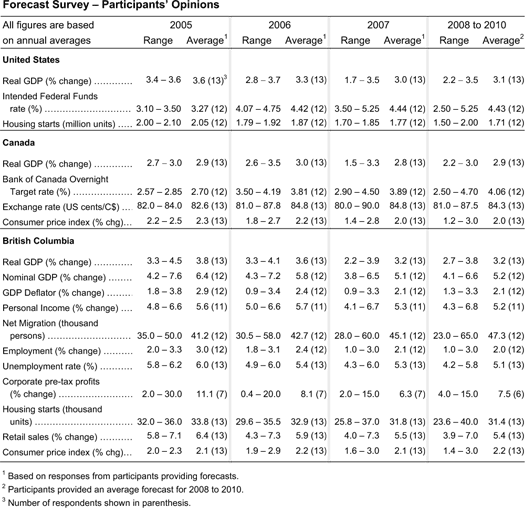The Economic Forecast Council, 2006
Introduction
Every year, the Minister of Finance seeks the advice of the Economic Forecast Council (the Council) on the outlook for the provincial economy prior to the annual budget and presents the forecasts with the budget. This consultation process is a requirement of the Budget Transparency and Accountability Act.
The Minister met with the Council on December 5, 2005 to discuss its estimates for 2005 and the economic outlook for 2006 and beyond.
Council members discussed their views of the province's near-term economic outlook, as well as factors affecting the province's medium-term outlook. Among various topics discussed were the Canadian dollar, the international outlook, commodity prices and the construction sector. This was followed by a discussion on capital spending and debt.
The underlying forecast details from the Council surveys, including one update in early January, are summarized in the table at the end of the topic box.
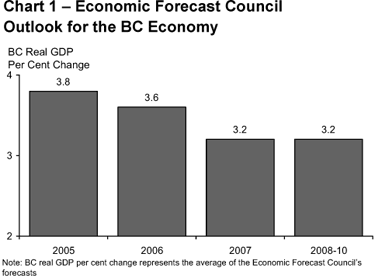
Overview
Following estimated growth in the British Columbia economy of 3.8 per cent in 2005, the average of participants' forecasts called for growth of 3.6 per cent in 2006, 3.2 per cent in 2007 and 3.2 per cent for the 2008 to 2010 period. Council members saw BC as well positioned to post strong growth over the next couple of years relative to the other Canadian provinces. British Columbia was expected to outperform Canada through 2010. In the medium-term, Council members expected non-residential construction activity to be one of the key drivers of growth. Council members expect a strong domestic economy to be supported by a number of other factors including healthy consumer spending, steady housing activity, continued demand for British Columbia's natural resources, growing trade with Asia and improved fiscal flexibility of the provincial government.
While most Council members agreed that government should have a long-term capital and debt strategy, many felt that government should not limit itself to decisions that focus solely on achieving a specific target for the debt-to-GDP ratio.
The main forecast risk mentioned by Council members was the issue of labour and material shortages and costs due to the high level of activity in the construction industry. The outlooks for external economies as well as commodity prices were also significant concerns.
International Outlook
Following expected growth of 3.6 per cent in 2005, the participants' average forecast points to U.S. growth of 3.3 per cent in 2006 and 3.0 per cent in 2007, followed by 3.1 per cent for the 2008 to 2010 period.
Some Council members expect the U.S. economy to lose steam in the second half of 2006 and into 2007 as consumer spending and housing activity slows. There was also concern surrounding the twin deficit problem in the U.S. and its potential impact on growth over the medium term.
Most Council members felt that global growth prospects would remain buoyant, especially in Asia and other developing countries. While some Council members expect the strength in China to continue, others felt that the Chinese economy would moderate over the medium-term.
The Canadian Economy
After seeing the Canadian economy benefit from strong commodity prices and continued strength in domestic demand in 2005, the Council is now divided on how the Canadian economy will perform in 2006. About half of the members expect the Canadian economy to do better than last year, while others expect no change, or a slightly weaker performance in 2006. The diverging views arise mainly on the trade sector, with some members expecting Canadian exports to moderate in line with an anticipated slower pace of manufacturing shipments destined to the U.S. Some Council members also expect Canadian import growth to moderate in line with softer domestic demand, while others expect import growth to remain strong due to increased machinery and equipment spending. On the domestic side, some Council members expect business investment in Canada to remain strong in response to non-residential construction activity in the energy sector as well as major infrastructure projects.
For 2006, Canadian growth was forecast to be 3.0 per cent on average, slowing to an average forecast of 2.8 per cent in 2007 before rising slightly to 2.9 per cent on average for 2008 through 2010.
The continued appreciation of the Canadian dollar, potential weakness in the US economy, competitive pressures from lower-cost international producers and weak productivity were the biggest concerns in terms of risks to Canadian economic growth.

Financial Markets
Most Council members felt that the Federal Reserve would continue to raise the Federal Funds rate in 2006 to stem inflationary concerns in the U.S. Higher interest rates were expected to dampen the U.S. housing market, which could negatively impact BC's forestry exports.
The intended federal funds rate1 was projected to be 4.42 per cent on average in 2006, rising slightly to 4.44 per cent in 2007 on average. Over the 2008 to 2010 period the intended federal funds rate forecasts averaged 4.43 per cent.
In Canada, the Council generally felt that the Bank of Canada would also raise interest rates in 2006, with the overnight target rate2 expected to average 3.81 per cent for the year. The interest rate spread between the U.S. and Canada was expected to narrow on average over the medium term. The Bank of Canada's overnight target rate was forecast to average 3.89 per cent in 2007 and 4.06 per cent over the 2008 to 2010 period.
The Council's average forecast for the exchange rate was 84.8 cents US in 2006, up from 82.6 cents US in 2005. Forecasts ranged from a low of 81.0 cents up to a high of 87.8 cents. In 2007, the average of participants' exchange rate forecasts was also 84.8 cents US with slightly more than half expecting a steady or depreciating Canadian dollar. On average, the Council expects the Canadian dollar to hold steady over the medium term to average 84.3 cents US for 2008 to 2010. Council members continued to have divergent views on the level of the Canadian dollar over the medium term, although the range of participants' opinions narrowed somewhat.
Over the 2008 to 2010 period, the range of Council members forecasts of the Canadian dollar was from 81.0 cents US up to 87.5 cents US.
| 1 | The intended federal funds rate is the interest rate at which depository institutions lend balances at the Federal Reserve to other depository institutions overnight. |
| 2 | The overnight target rate is the midpoint of the Bank of Canada’s operating band for overnight financing. |
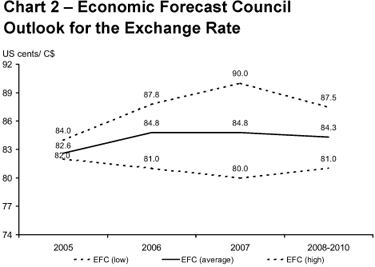
The value of the Canadian dollar over the medium-term is a concern for most Council members. Council members recognized the potential upsides and downsides to a stronger currency. Some members questioned whether the Canadian economy has fully adjusted to the higher valued currency. Stronger commodity prices, further depreciation of the U.S. dollar and the U.S. twin deficit situation were cited by some Council members as reasons to expect further appreciation in the Canadian dollar.
British Columbia Forecast
On average, participants expected BC's economy to post growth of 3.6 per cent in 2006, 3.2 per cent in 2007 and 3.2 per cent during the 2008 to 2010 period. All of the Council members are expecting BC to outperform Canada in 2006. Increased activity in the non-residential construction sector is expected to be one of the key drivers of growth in the coming years. Participants cited strong employment gains, healthy consumer spending, steady housing activity, continued demand for BC's natural resources, the turn around in BC's fiscal position, the province's ties to Asia, and an anticipated build up towards the 2010 Olympics as reasons for BC's strong performance.
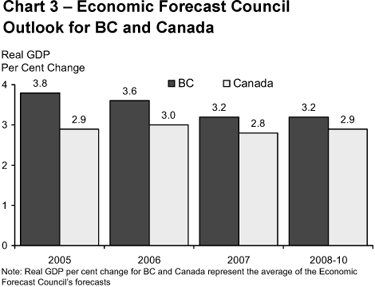
As shown in Chart 4, Council members views were relatively convergent on their BC growth forecast for 2006. For 2007, there was a strong consensus in the 3.4-to-3.6 per cent growth range, but several more conservative forecasts reduced the average growth (see Chart 5).
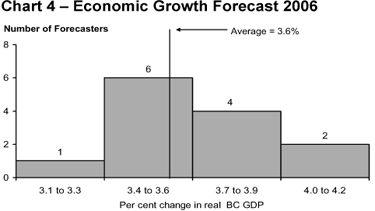
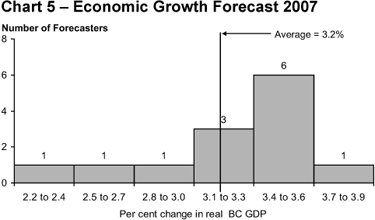
For the longer term forecast for the 2008-10 period there were divergent views. Council members were almost evenly divided with five members expecting growth of 3.4 per cent or higher, and another five members predicting growth of 3.0 per cent or less. The remaining three members expect growth in the 3.1 per cent to 3.3 per cent range (see Chart 6).
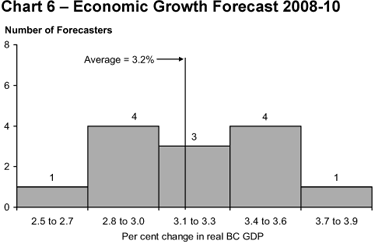
External Issues
The Council discussed the uncertainty surrounding the U.S. outlook, and the economy's vulnerability due to the over-heated housing market, volatile energy prices and the twin deficits. While BC's economy has a diversified export market, the U.S. is still the province's major trading partner and a downturn in the U.S. economy would have a significant negative impact on BC.
In addition, participants noted that BC is well positioned to benefit from increased trade with Asia, especially China. In particular, infrastructure improvements including ports, railways and border crossings will help BC make the most of the province's geographical proximity to rapidly expanding Asian markets. However, some Council members mentioned that BC's Pacific Rim gateway status would make the provincial economy increasingly sensitive to Asia's prospects. Potential resolution of the softwood lumber dispute with the U.S. was also mentioned by the Council as a positive factor for the BC outlook.
Council members discussed commodity prices and energy prices and the potential for them to remain at high levels due to continued strong demand from Asia, particularly China. On a positive note, some members mentioned that high energy prices would continue to support development of BC's oil and gas industry.
Sectoral Issues
In terms of the domestic economy, the Council discussed the areas of housing, immigration and labour markets.
Most Council members expect the housing sector to moderate slightly in 2006, in part due to higher interest rates. The Council on average saw housing starts averaging 32,867 units in 2006, down from 33,758 in 2005. There was a wide range of forecasts of housing starts in 2006, from 29,632 units up to 35,500 units. The Council expects housing starts to average 31,760 units in 2007 and 31,411 units over the 2008 to 2010 period.
Total net migration to BC was expected to increase in 2006, relative to the level seen in 2005, with the Council's forecasts averaging 42,654 people for 2006 compared to 41,179 people in 2005. The range of forecasts for total net migration was quite high, with a low of 30,538 people and a high of 58,000 people in 2006. Most Council members forecast total net migration in BC to increase over the medium term, though the range of forecasts is very large. The Council expects total net migration to average 45,072 people in 2007 rising to 47,343 over the 2008 to 2010 period.
The issue of labour and material shortages in BC and associated costs was the main medium-term concern of the Council. Many Council members expressed concern that there may not be enough workers to complete all the planned construction projects in BC over the next few years, and that the high level of activity in the BC construction industry may put upward cost pressures on materials and labour. The Council also noted that demographic trends would exacerbate labour shortages over the medium term, and that BC needed to promote its strength as a desirable place to live to successfully compete in the labour market for skilled workers. Alberta's buoyant economy was also mentioned as a contributing factor to the problem of rising materials costs and shortages of trades workers in BC.
On a positive note, infrastructure projects planned for the 2010 Olympics represent a significant investment in infrastructure, and Council members expect the BC economy to benefit from the rise in non-residential construction and a boost to tourism through the medium-term. Council members further mentioned that government should also take advantage of the period after the 2010 Olympics as an opportune time to advance public sector capital projects.
The Council expressed concerns about the mountain pine beetle infestation and its potential impact on the BC economy. Several members mentioned that accelerated harvest activity to salvage beetle-killed wood would provide additional stimulus to the Interior region of the province and provide a boost to forestry and wood manufacturing output over the next several years.
Council members also commented on BC's mediocre productivity performance. They agreed that attaining robust productivity growth is a challenge because of BC's large service sector. However, Council members concurred that the government has initiated the policies needed to increase productivity growth in the province, and should continue to build on its achievements.
Several Council members also mentioned public sector wage settlements as a concern over the medium-term for BC.
Government
The improved fiscal position of government and the positive business climate in BC were also noted as strengths by Council members. The Council mentioned that by balancing the provincial budget, government has more fiscal flexibility. In addition, the government has more flexibility to maintain a competitive tax regime and invest in infrastructure.
This improved environment also assists government in positioning itself with an appropriate capital spending and debt strategy. To this effect, Council members mentioned that government should focus on establishing a declining or stable debt-to-GDP ratio, and not necessarily a fixed target for the ratio. This implies that government activity should be done in a cost-effective manner, and not necessarily driven by a desire to achieve a targeted level for the debt-to-GDP ratio. Council members mentioned that it is acceptable for debt levels to rise (within reason) to fund important capital spending initiatives, but that a rising debt-to-GDP ratio would raise concern.
